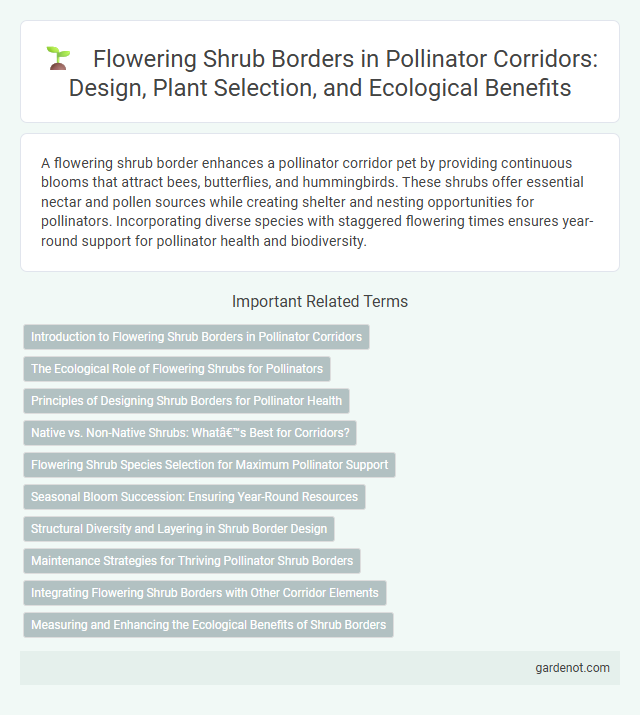A flowering shrub border enhances a pollinator corridor pet by providing continuous blooms that attract bees, butterflies, and hummingbirds. These shrubs offer essential nectar and pollen sources while creating shelter and nesting opportunities for pollinators. Incorporating diverse species with staggered flowering times ensures year-round support for pollinator health and biodiversity.
Introduction to Flowering Shrub Borders in Pollinator Corridors
Flowering shrub borders are critical components of pollinator corridors, offering diverse nectar and pollen sources throughout multiple seasons to support pollinator health and biodiversity. Species such as Ceanothus, Salvia, and Buddleia attract bees, butterflies, and hummingbirds by providing continuous bloom cycles and essential habitat structure. Integrating native flowering shrubs enhances ecological connectivity, promoting pollinator movement and resilience within fragmented landscapes.
The Ecological Role of Flowering Shrubs for Pollinators
Flowering shrub borders provide essential nectar and pollen sources that sustain diverse pollinator populations, including bees, butterflies, and hummingbirds, throughout their active seasons. These shrubs create critical habitats and shelter, enhancing pollinator biodiversity and supporting ecological resilience in fragmented landscapes. Incorporating native flowering shrubs into pollinator corridors significantly boosts pollination services, contributing to healthier ecosystems and improved crop yields.
Principles of Designing Shrub Borders for Pollinator Health
Designing flowering shrub borders for pollinator health involves selecting native, nectar-rich species that bloom sequentially from early spring to late fall, ensuring continuous food supply for diverse pollinators. Incorporating varied shrub heights and dense foliage creates sheltered habitats for nesting and protection from predators. Avoiding pesticides and providing nearby water sources further enhances pollinator survival and biodiversity in these corridors.
Native vs. Non-Native Shrubs: What’s Best for Corridors?
Native flowering shrubs, such as chokeberry (Aronia) and elderberry (Sambucus), provide essential nectar and pollen resources tailored to local pollinators, enhancing biodiversity within pollinator corridors. Non-native shrubs often lack specialized relationships with indigenous pollinators, potentially disrupting ecosystem balance and reducing pollination efficiency. Prioritizing native shrubs in flowering borders supports robust pollinator populations and promotes sustainable corridor habitats.
Flowering Shrub Species Selection for Maximum Pollinator Support
Selecting flowering shrub species with high nectar and pollen yields, such as Ceanothus, Buddleja, and Sambucus, significantly enhances pollinator corridor effectiveness by attracting diverse pollinator species including bees, butterflies, and hummingbirds. Emphasizing native shrub varieties adapted to local climates ensures sustained bloom periods and resilience while providing essential habitat and forage throughout the pollinator active season. Incorporating a succession of flowering shrubs with staggered bloom times maximizes continuous resource availability, supporting pollinator health and biodiversity.
Seasonal Bloom Succession: Ensuring Year-Round Resources
A flowering shrub border designed for pollinator corridors prioritizes seasonal bloom succession to provide continuous nectar and pollen sources throughout the year. Selecting a diverse mix of native shrubs such as Ceanothus in spring, Buddleia in summer, and Viburnum in fall ensures that pollinators have consistent foraging opportunities. This strategic planting supports the health and biodiversity of pollinator populations by preventing resource gaps during critical periods.
Structural Diversity and Layering in Shrub Border Design
In pollinator corridors, flowering shrub borders enhance habitat complexity through structural diversity and layering, creating vertical and horizontal variation that supports multiple pollinator species. Incorporating a mix of shrub heights and bloom times increases resource availability and shelter, fostering pollinator foraging and nesting opportunities. This diverse layering supports ecosystem resilience and promotes continuous pollinator activity throughout the growing season.
Maintenance Strategies for Thriving Pollinator Shrub Borders
Regular pruning of flowering shrub borders encourages vigorous growth and prolonged blooming periods, essential for sustaining pollinator populations. Mulching around the base helps retain soil moisture and suppresses weeds, creating an optimal habitat for pollinators. Integrating seasonal inspections to identify pests and diseases early ensures the health and resilience of pollinator-friendly shrubs.
Integrating Flowering Shrub Borders with Other Corridor Elements
Flowering shrub borders enhance pollinator corridors by providing essential nectar sources and shelter, creating a diverse habitat that supports various pollinator species. Integrating these shrub borders with native wildflower meadows and nectar-rich herbaceous plants maximizes continuous bloom periods and resource availability. This strategic combination improves pollinator health and biodiversity by facilitating foraging, nesting, and movement throughout the corridor.
Measuring and Enhancing the Ecological Benefits of Shrub Borders
Measuring the ecological benefits of flowering shrub borders within pollinator corridors requires assessing parameters like pollinator visitation rates, species diversity, and seasonal bloom periods to optimize habitat value. Enhancing these borders with native flowering shrubs that provide continuous nectar and pollen sources supports diverse pollinator populations and improves ecosystem resilience. Incorporating bioindicators and remote sensing technologies facilitates monitoring shrub health and pollinator activity, ensuring adaptive management strategies for maximum ecological impact.
Flowering shrub border Infographic

 gardenot.com
gardenot.com